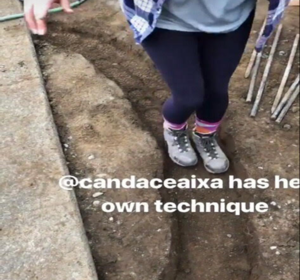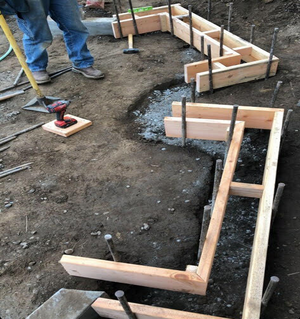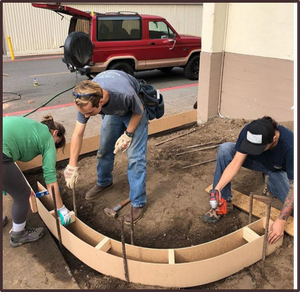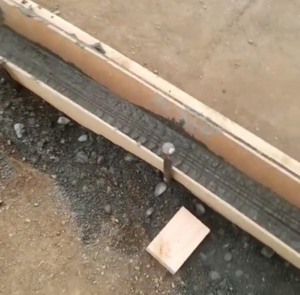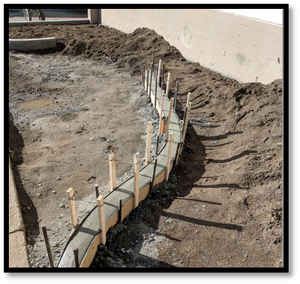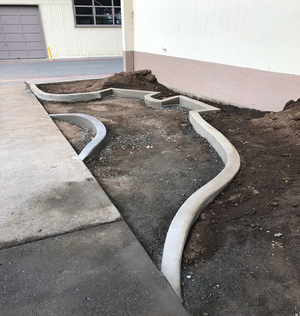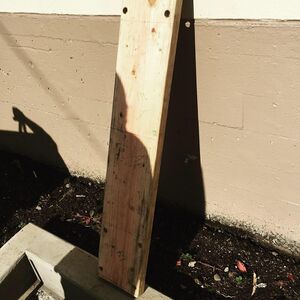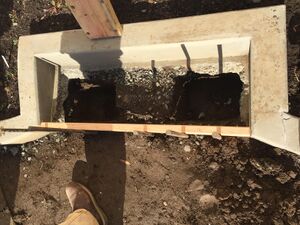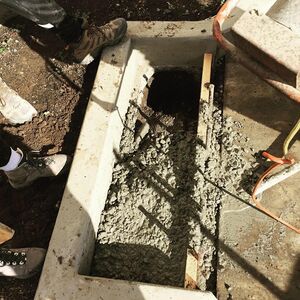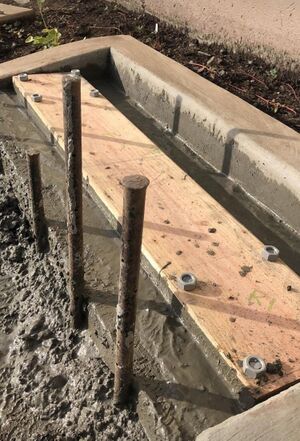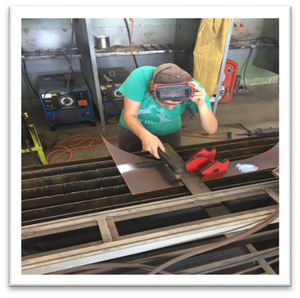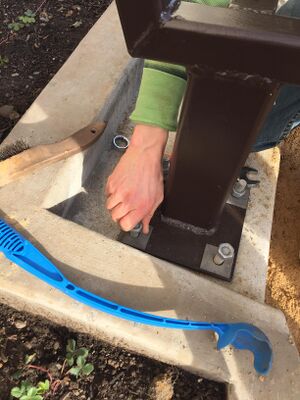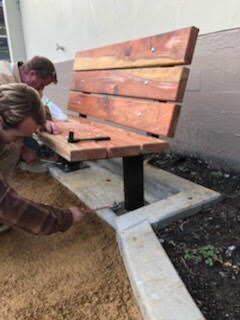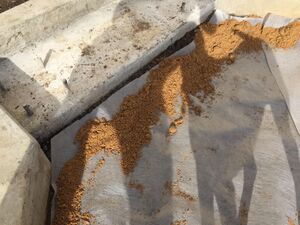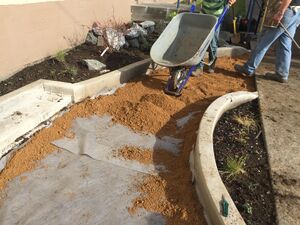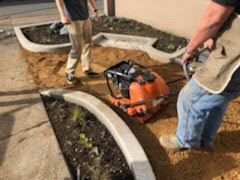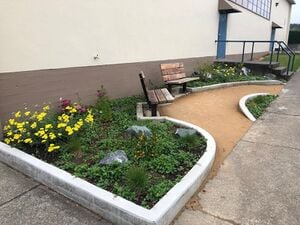
The objective of this project is to transform an outdoor common area located at Six Rivers Charter High School. The improvements made are to provide a place to sit as well as promote a locale for outdoor learning. Team Cacio e Pepe worked closely with Six Rivers to add a native element to the preexisting spaces. Cacio e Pepe was brought together through the Cal Poly Humboldt class, Engineering 215 - Introduction to Design, taught by Lonny Grafman.
Background[edit | edit source]
Six Rivers Charter High School (SRCHS) is located next to Arcata High School in Arcata, CA. They have been teaching students to become independent learners since 2003. Over the last 15 years SRCHS has offered college preparatory classes in small class room environments, so teachers have the ability to nurture each of the 100 students individually. A small access road separates the two schools, with very little places to sit during breaks and lunch. SRCHS contacted Lonny Grafman of Cal Poly Humboldt (HSU) to transform some of the open space between the schools into an inviting environment with seating and educational impact. The common area picked to be transformed was a 30 by 10 foot grassy area against the South facing wall of the auto shop.
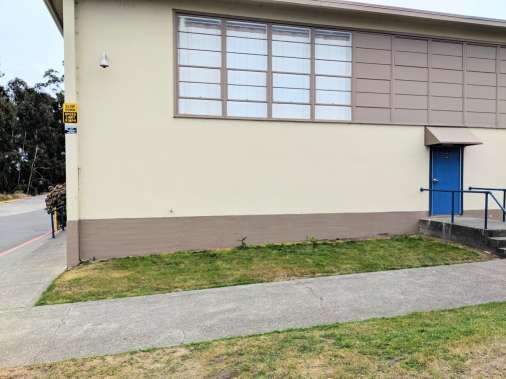
Problem Statement and Criteria[edit | edit source]
The students at Six Rivers Charter High School have an 8 hour school day in which a majority of that time is spent indoors. The transformation of this space should serve the students as a place to decompress during breaks as well as promote a locale for outdoor learning.
In order to make this transformation successful the members of Cacio e Pepe created a criteria with Six Rivers. The criterion were weighted in order of importance to meet the specifications mentioned above.
| Criterion | Constraints | Weight |
|---|---|---|
| Utility | The number of functions this space can provide will be constrained by its size and the time allocated to complete the transformation. | 10 |
| Aesthetics | The aesthetics need to be done in a way that is inviting for the students. The aesthetics will also perpetuate future transformations of other outdoor common areas. | 10 |
| Sustainability | The landscape should be dual purpose in that it is aesthetically pleasing but also edible. Building materials used must be sourced from recycled materials in all possible ways. | 9 |
| Longevity | Should last for at least 10 years in Arcata climate with regular care and maintenance. | 7 |
| Cost | Limited to $375 | 5 |
Description of final project[edit | edit source]
The final design includes a pathway leading to two benches. The pathway was designed to serve as an invitation to students to utilize the space during breaks. It also provided the flow for the overall space, blending the transformation with the preexisting environment meeting the aesthetic criterion. A native landscape within the flowing retaining wall was chosen to lower maintenance cost meeting the sustainable criterion. The landscape also included edible plants which can be used for Six Rivers culinary class. This meets the utility criterion.
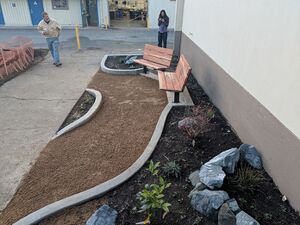
Prototyping[edit | edit source]
Cacio e Pepe presented several designs that would follow the criteria and meet the specifications established by Six Rivers. The following prototypes were chosen by the client.
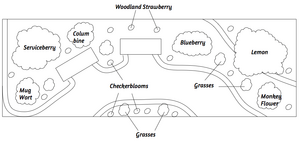
The CAD drawing above is the Six Rivers desired design. By presenting multiple design ideas, Cacio e Pepe was able to distinguish the environment in which Six Rivers was seeking with the transformation. A natural design was the preferred design.
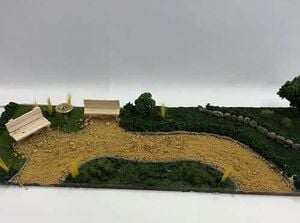
Cacio e Pepe prototyped a to-scale model of the transformation. This model allowed the team to gauge the space and placement of the elements implemented into the transformation.
Costs[edit | edit source]
Total material cost: $ 874.64. Total hours spent on project 325+. A majority of the total cost was donated by the following local businesses: The Mill Yard, Eureka Ready Mix, Thomas Home Center, Miller Farms, Mad River Gardens, Wes Green Landscape, Lost Foods Native Plant Nursery, Forest Lakes Nursery, O&M Industries, and Don's Rent-All.
| Quantity | Material | Source | Cost ($) | Total ($) |
|---|---|---|---|---|
| 2 | Marking Flags | Hensel's Ace | 3.59 | 7.18 |
| 1 | Marking Tape | Hensel's Ace | 8.99 | 8.99 |
| 1 | Marking Paint | Hensel's Ace | 8.67 | 8.67 |
| 7 | Concrete | Mill Yard | 15.45 | 108.11 |
| 2 | Concrete | Thomas Home Center | 21.22 | 42.43 |
| 1 | Concrete Stakes | The Mill Yard | 33.63 | 33.63 |
| 16 | 10" J-bolts with Washers | The Mill Yard | 2.29 | 36.64 |
| 16 | J-bolt nuts | The Mill Yard | 0.59 | 9.44 |
| 1 | 8'x4"x2" Douglas Fir | The Mill Yard | 12.40 | 12.40 |
| 1 | 4'x8'x1/4" Masonite | The Mill Yard | 39.98 | 39.98 |
| 4 | 5/8"x20' Rebar | The Mill Yard | 12.99 | 51.96 |
| 1 | 3/8"x20' Rebar | Thomas Home Center | 6.99 | 6.99 |
| 1 | 40'x2"x8" Doug Fir | Thomas Home Center | 51.30 | 51.30 |
| 1 | Misc. Hardware | Thomas Home Center | 5.99 | 5.99 |
| 1 | Yard Compost | Wes Green Landscaping | 48.49 | 48.49 |
| 1 | Blueberry Bush | Mad River Gardens | 42.99 | 42.99 |
| 1 | 1 Lemon Tree | Miller Farms Nursery | 42.99 | 42.99 |
| 1 | Misc. Flora | Lost Coast Native Plants | 74.50 | 74.50 |
| 1 | Misc. Flora | Forest Lakes Nursery | 52.99 | 52.99 |
| 3 | Yard Decomposed Granite | Wes Green | 62.99 | 188.97 |
| Total Cost | $874.64 | |||
How to build[edit | edit source]
Securely fasten forms in the shape and height of the desired footing using stakes and screws.
Remove the template leaving the fastening system in place. Finish the concrete slab using concrete tools. Put the template back on and repeat steps 5 and 6 for several hours.
If the frame has a bend from the seat to back, bend the frame piece.
Drill 4 holes in each bench foot that will attach the finished frame to the j-bolts in the bench footing.
Weld the bench frame pieces together.
Maintenance[edit | edit source]
The landscaping classes held at Six Rivers and Arcata High Schools will be responsible for the basic gardening maintenance needed to upkeep the native garden. If any maintenance is needed on the decomposed granite (DG) pathway or benches, the teachers and staff at the schools will be responsible for minor repairs.
Schedule[edit | edit source]
- Weekly
- Directly after planting the native garden, it will need to be water for six months in the absence of rain, until the newly planted flora has adjusted to its new home.
- Monthly
- Weeding if needed.
- Harvesting native edibles.
- Yearly
- Pruning and cutting back shrubs and other overgrown plants.
- If there has been a large storm event, the DG pathway may need light resurfacing.
- Every 10-20 years
- Replace redwood bench slats if needed.
Discussion and next steps[edit | edit source]
For future steps if not achieved by the end of the semester, will include laying mulch down within the planter to add a finished look and to provide nutrients to the developing plants and to make plaques that provide the genus name of the plants. Cacio e Pepe would eventually like to add a social media tag located on site so that students can #cacio_corner their moments utilizing the space.
Follow us on instagram @team_cacio to see the whole process of this transformation and future changes.
Suggestions for future changes[edit | edit source]
The design of the transformation was meant to last for over 20 years. Therefore, if changes are to be made they will more than likely occur within the garden. This space has room to increase its functionality and serve the students in many more avenues. Cacio e Pepe foresees future additions to the space not necessarily changes. This transformation will perpetuate future transformations to spaces similar to this.
